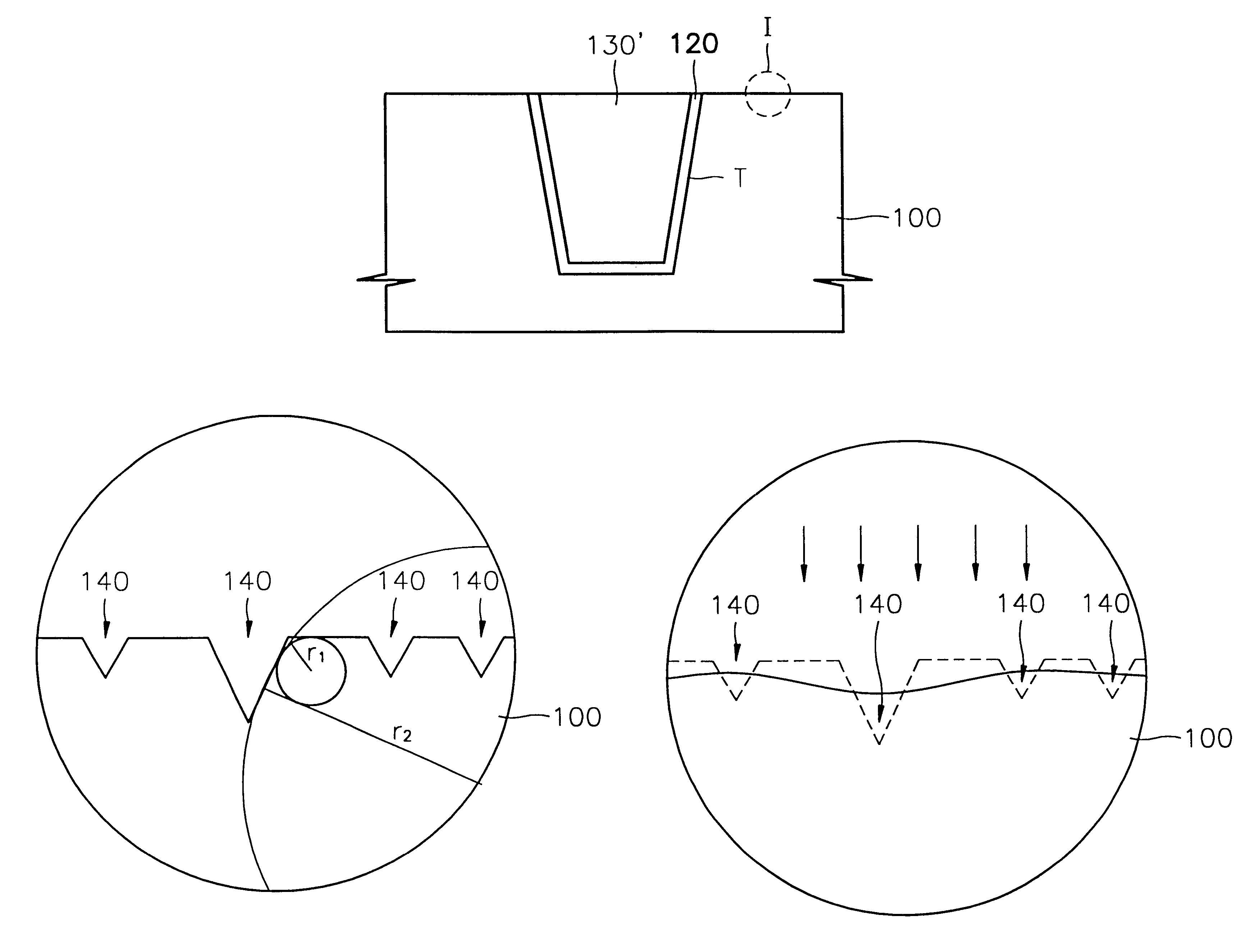Method of fabricating a semiconductor device using trench isolation method including hydrogen annealing step
a technology of trench isolation and semiconductor devices, applied in the direction of semiconductor devices, basic electric elements, electrical equipment, etc., can solve the problems of increasing manufacturing costs, reducing the thickness of field oxide films, and unable to electrically isolate adjacent semiconductor devices
- Summary
- Abstract
- Description
- Claims
- Application Information
AI Technical Summary
Problems solved by technology
Method used
Image
Examples
first embodiment
In a test performed by the inventor, it was confirmed that the CMP etching selection ratio of the semiconductor substrate 100 to the gap filling dielectric layer 130 and the CMP etching selection ratio of the semiconductor substrate 100 to the thermal oxide film 120 were about 1:17, when the pH of slurry was maintained at about 7. Accordingly, it was seen that the semiconductor substrate 100 itself can be used as a CMP stopper when slurry of the ceria family is used, so that the amount of CMP can be constantly maintained to obtain an isolation layer 130' having a uniform thickness. It was also confirmed in the test that since the CMP etching selection ratio of the semiconductor substrate 100 to the gap filling dielectric layer 130 is small when CMP slurry of the silica family is used, it is difficult to use the semiconductor substrate 100 as a CMP stopper. In other words, if slurry of the silica family is used when the gap filling dielectric layer 130 is planarized by a CMP method, ...
second embodiment
In the second embodiment of the present invention, a thin nitride liner 125 is formed on the thermal oxide film 120 before forming the gap filling dielectric layer 130 for filling the trench T. The nitride liner 125 is used as a planarization stop layer during planarization of the gap filling dielectric layer 130.
Referring to FIG. 2A, in the same manner as in the first embodiment, a photoresist pattern (not shown) is formed, a trench T is formed in a semiconductor substrate 100 using the photoresist pattern as an etching mask, the photoresist pattern is removed, and, subsequently, a thermal oxide film 120 is formed on the entire surface of the semiconductor substrate 100.
Next, a thin nitride liner 125 is formed along the surface topology of the thermal oxide film 120. The nitride liner 125 may be formed by methods such as CVD, SACVD, LPCVD or PECVD. The nitride liner 125 prevents oxidation of the side wall of the trench T during a succeeding step of filling the trench T with the gap...
third embodiment
Unlike the second embodiment, a pad insulating layer 105 is formed on a semiconductor substrate before forming a photoresist pattern 110 in a third embodiment.
Referring to FIG. 3A, a pad insulating layer 105 is formed on a semiconductor substrate 100. The pad insulating layer 105 may be a silicon oxide layer or a silicon oxy nitride layer. When the pad insulating layer 105 is formed of silicon oxide layer, thermal oxidation may be used. When the pad insulating layer 105 is formed of a silicon oxy nitride layer, a CVD method, an LPCVD method, an SACVD method or a PECVD method may be used. The pad insulating layer 105 is preferably formed to a thickness that does not increase the aspect ratio of a trench T substantially when the trench T is filled with a gap filling dielectric layer later 130. The pad insulating layer 105 may be formed to a thickness of 100-1500 .ANG., and preferably, to a thickness of 500 .ANG.. After forming the pad insulating layer 105, a photoresist pattern 110 is...
PUM
 Login to View More
Login to View More Abstract
Description
Claims
Application Information
 Login to View More
Login to View More - R&D
- Intellectual Property
- Life Sciences
- Materials
- Tech Scout
- Unparalleled Data Quality
- Higher Quality Content
- 60% Fewer Hallucinations
Browse by: Latest US Patents, China's latest patents, Technical Efficacy Thesaurus, Application Domain, Technology Topic, Popular Technical Reports.
© 2025 PatSnap. All rights reserved.Legal|Privacy policy|Modern Slavery Act Transparency Statement|Sitemap|About US| Contact US: help@patsnap.com



